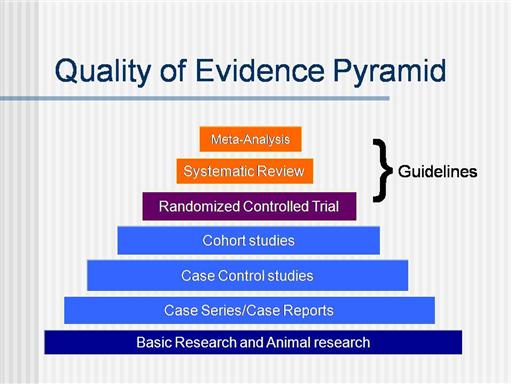| front |1 |2 |3 |4 |5 |6 |7 |8 |9 |10 |11 |12 |13 |14 |15 |16 |17 |18 |19 |20 |21 |22 |23 |24 |25 |26 |27 |28 |29 |30 |31 |32 |33 |34 |35 |36 |37 |38 |39 |40 |41 |42 |43 |44 |45 |46 |47 |48 |49 |50 |51 |52 |53 |review |
 |
This is often referred to as the "evidence pyramid". It is used to illustrate the evolution of the literature. The base of the pyramid is where information usually starts with an idea or laboratory research. As these ideas turn into drugs and diagnostic tools they are tested in laboratories models, then in animals, and finally in humans. The human testing may begin with volunteers and go through several phases of clinical trials before the drug or diagnostic tool can be authorized for use within the general population. Randomized controlled trials are then done to further test the effectiveness and efficacy of a drug or therapy. As you move up the pyramid the amount of available literature decreases, but increases in its relevance to the clinical setting. Meta-Analysis takes the systematic review (see below) a step further by using statistical techniques to combine the results of several studies as if they were one large study. Systematic Reviews usually focus on a clinical topic and answer a specific question. Extensive literature searches are conducted to identify studies with sound methodology. The studies are reviewed, assessed, and summarized according to the predetermined criteria of the review question. Randomized Controlled Trials are carefully planned projects that study the effect of a therapy or test on real patients. They include methodologies that reduce the potential for bias and that allow for comparison between intervention groups and control groups (no intervention). Evidence for questions of diagnosis is found in prospective trials which compare tests with a reference or "gold standard" test. Cohort Studies take a large population and follow patients who have a specific condition or receive a particular treatment over time and compare them with another group that is similar but has not been affected by the condition being studied. Cohort studies are not as reliable as randomized controlled studies, since the two groups may differ in ways other than in the variable under study. Case Control Studies are studies in which patients who already have a specific condition are compared with people who do not. These types of studies are often less reliable than randomized controlled trials and cohort studies because showing a statistical relationship does not mean than one factor necessarily caused the other. Case Series consist of collections of reports on the treatment of individual patients. Case Report is a report on a single patient. Because they are reports of cases and use no control groups with which to compare outcomes, they have no statistical validity . Practice Guidelines are systematically developed statements to assist practitioner and patient make decisions about appropriate health care for specific clinical circumstances. Guidelines review and evaluate the evidence and then make explicit recommendations for practice. The pyramid serves as a guideline to the hierarchy of evidence available. You may not always find the best level of evidence to answer your question. In the absence of the best evidence, you then need to consider moving down the pyramid to other types of studies. |